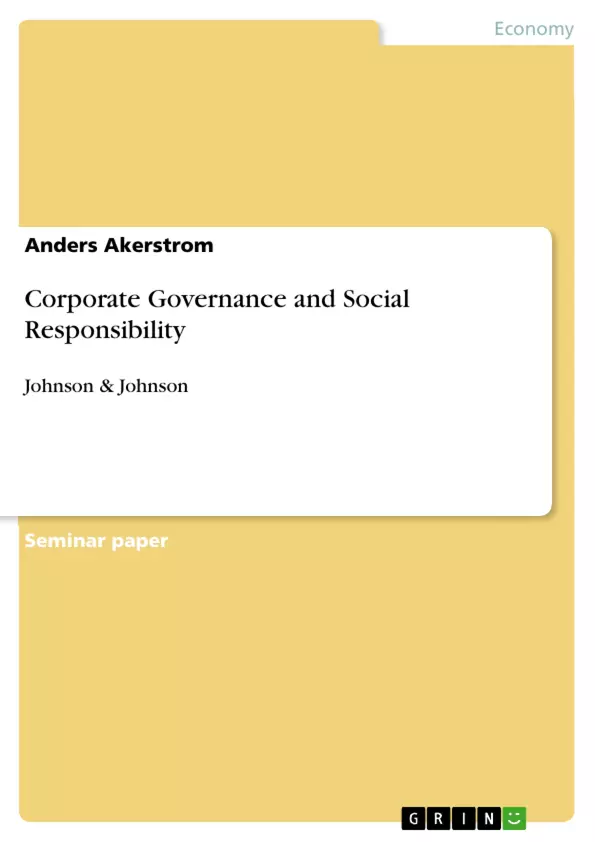The purpose of this report is to discuss the reasons behind the increased interest in Corporate Governance and Corporate Social Responsibility (CSR) in recent years and how Johnson & Johnson (J&J) utilizes the two concepts in its day-to-day business. First, the report gives an overview of Corporate Governance and CSR, and discusses the recent scandals in the corporate world. The second part focuses on J&J’s Corporate Governance and CSR practices. The company communicates its Credo through its actions towards its customers, employees, communities and environment as well as its shareholders.
Table of Contents
- Executive Summary
- Introduction
- Corporate Governance and Corporate Social Responsibility Overview
- Corporate Social Responsibility Framework
- Why Corporate Governance and Corporate Social Responsibility
- Johnson & Johnson Overview
- Johnson & Johnson's Strategies
- Customers
- Employees
- Communities and the Environment
- Shareholders
- Conclusion
- Recommendations
Objectives and Key Themes
This report examines the rising interest in Corporate Governance and Corporate Social Responsibility (CSR) and how Johnson & Johnson (J&J) incorporates these concepts into its operations. The report analyzes recent scandals and shareholder activism that have fueled this interest, exploring the relationship between these two concepts. It then delves into J&J's commitment to Corporate Governance and CSR, particularly through its Credo, and assesses the impact of these practices on various stakeholders.
- The emergence and evolution of Corporate Governance and CSR
- The impact of scandals and shareholder activism on the corporate world
- The role of J&J's Credo in guiding the company's CSR practices
- The relationship between Corporate Governance and CSR
- The benefits and challenges of integrating CSR into business operations
Chapter Summaries
The report begins with an introduction outlining the purpose and structure of the analysis. It then proceeds to provide a detailed overview of Corporate Governance and CSR, highlighting the historical context, recent scandals, and the evolving definition of CSR. The report also examines the conceptual framework of CSR, exploring Carroll's "Pyramid of Corporate Social Responsibility" and its subsequent development. The report concludes by presenting a case study of J&J, emphasizing the company's strong commitment to Corporate Governance and CSR, exemplified by its Credo, which prioritizes the needs of customers, employees, and the environment over shareholder interests. The report analyzes J&J's specific strategies for engaging with each stakeholder group and highlights the company's commitment to sustainable and responsible business practices.
Keywords
This report focuses on the interconnected concepts of Corporate Governance, Corporate Social Responsibility (CSR), and stakeholder engagement. It explores the impact of recent scandals, shareholder activism, and the rise of social responsible investors on the corporate landscape. The report examines the evolution of CSR, the theoretical frameworks guiding its development, and the importance of aligning business practices with ethical principles. It highlights the role of J&J's Credo in shaping the company's CSR strategy and emphasizes the company's commitment to responsible business practices across all stakeholder groups.
- Quote paper
- Anders Akerstrom (Author), 2009, Corporate Governance and Social Responsibility, Munich, GRIN Verlag, https://www.grin.com/document/137651



